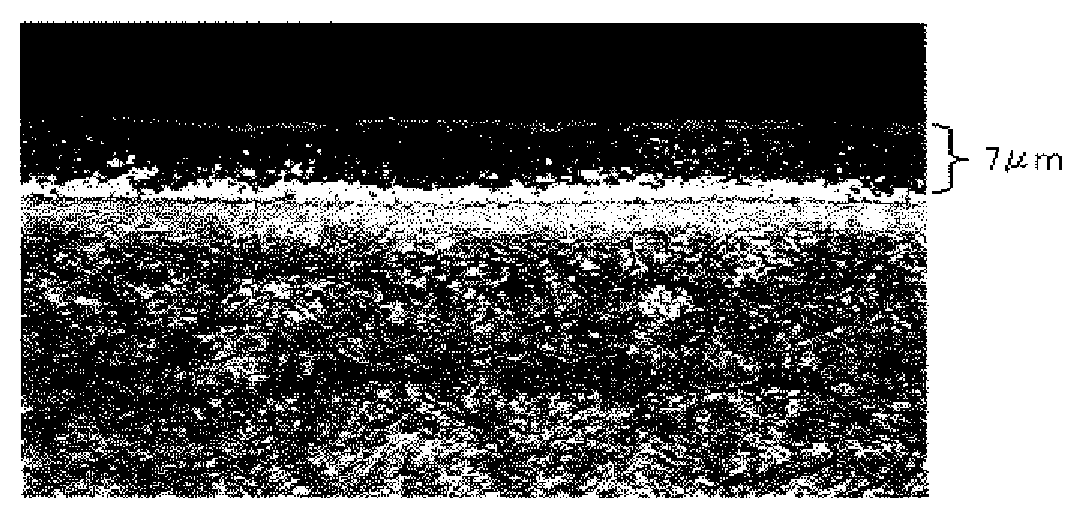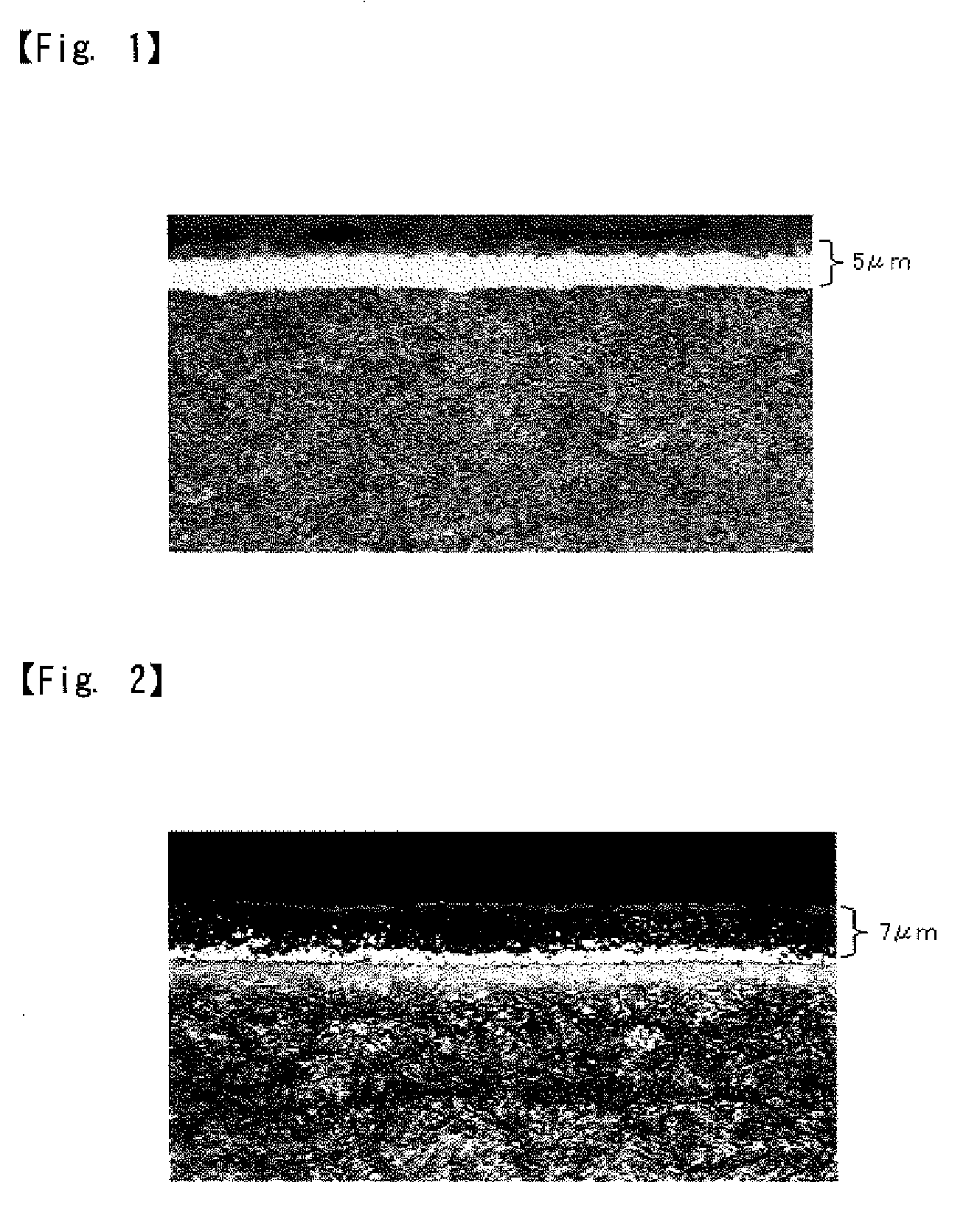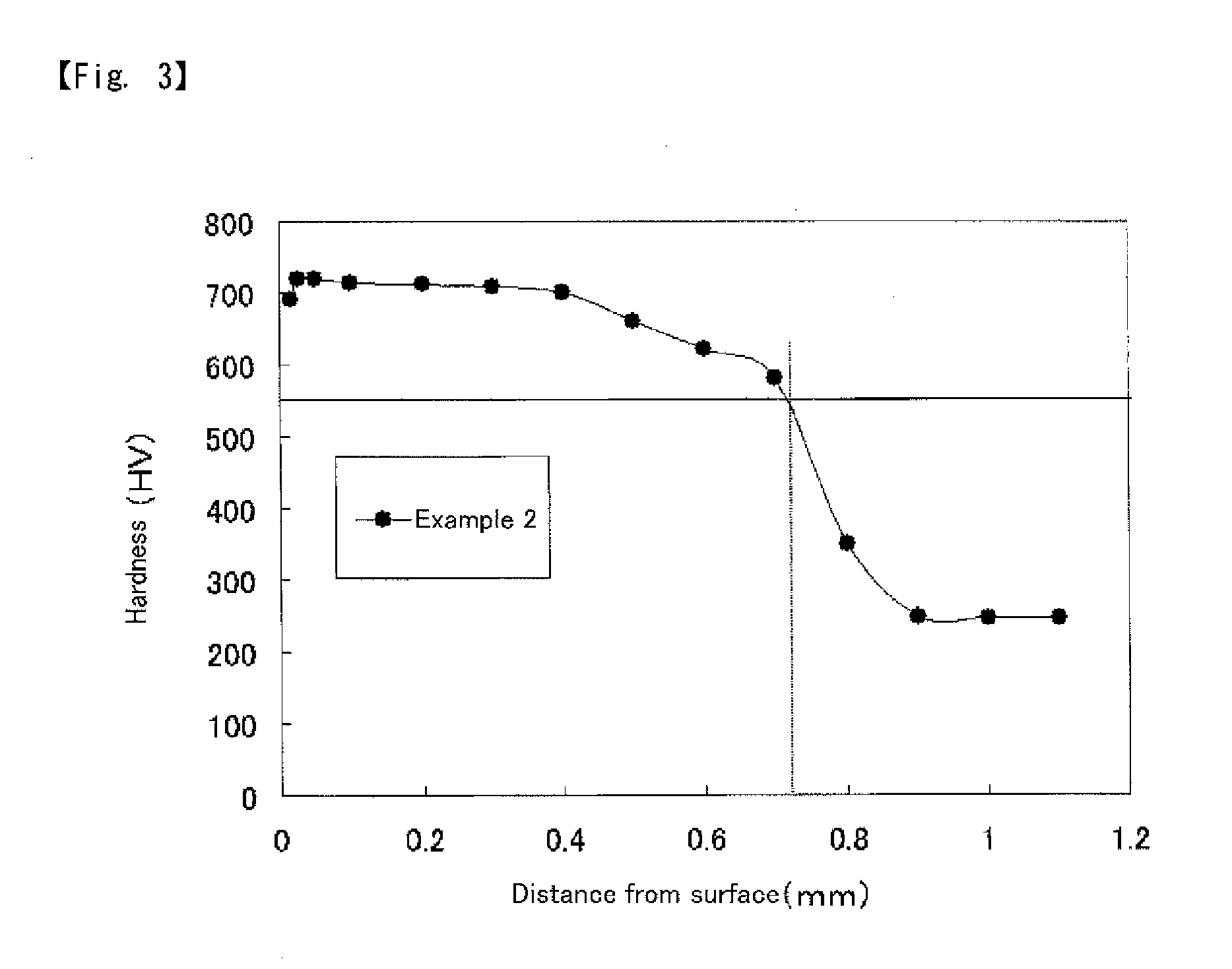Steel member having nitrogen compound layer and process for producing same
a technology of nitrogen compound layer and steel member, which is applied in the direction of other chemical processes, solid-state diffusion coating, coating, etc., can solve the problems of poor contact pressure strength, fatigue strength and the like of nitrogen compound layer, insufficient depth of hardened layer immediately below to fully exploit the good sliding of compound layer on the outermost surface, etc., to achieve good sliding, inhibit the oxidative degradation of compound layer, and improve quenchability
- Summary
- Abstract
- Description
- Claims
- Application Information
AI Technical Summary
Benefits of technology
Problems solved by technology
Method used
Image
Examples
example 1
[0054]Using an SCM 440 thermal refining steel material of 8 mm in diameter and 50 mm in length as a substrate, after degreasing its surface, it was nitrocarburized in a molten salt bath at 560° C. for one hour (Isonite treatment: Nihon Parkerizing Co., Ltd.), followed by oil cooling, to form a nitrogen compound layer based on iron nitride of approximately 7 μm in thickness on the surface of the steel material. This material was immersed in a surface conditioning liquid (PL-55, Nihon Parkerizing Co., Ltd.) for surface conditioning and then immersed in a manganese phosphate chemical conversion treatment liquid (PF-Ml A, Nihon Parkerizing Co., Ltd.) for chemical conversion treatment at 95° C. for one minute. The chemical conversion film was crystalline, mainly containing phosphoric acid, Mn and Fe, and had a film weight of 2.8 g / m2. The compound layer after the chemical conversion treatment had a thickness of approximately 5 μm. Using an induction quenching device, heating was carried ...
example 2
[0055]Using an S 45 C thermal refining steel material of 8 mm in diameter and 50 mm in length as a substrate, after degreasing its surface, it was nitrocarburized in a molten salt bath at 560° C. for two hours (Isonite treatment: Nihon Parkerizing Co., Ltd.), followed by oil cooling, to faun a nitrogen compound layer based on iron nitride approximately 13 p.m in thickness on the surface of the steel material. This material was immersed in a zirconium-based chemical conversion treatment liquid (PLC-2000, Nihon Parkerizing Co., Ltd.) for chemical conversion treatment at 45° C. for five minutes. The chemical conversion film was amorphous, mainly containing Zr, Fe, a fluoride and a hydroxide, and had a film weight of 0.3 g / m2. The nitrogen compound layer after chemical conversion treatment had a thickness of approximately 13 μm, showing little change in thickness of the compound layer by the chemical conversion treatment. Using an induction quenching device, heating was carried out for ...
example 3
[0056]Using an SCM 435 thermal refining steel material of 8 mm in diameter and 50 mm in length as a substrate, after degreasing its surface, it was nitrocarburized in a molten salt bath at 560° C. for two hours (Isonite treatment: Nihon Parkerizing Co., Ltd.), followed by water cooling, to form a nitrogen compound layer based on iron nitride of approximately 10 μm in thickness on the surface of the steel material. This material was immersed in a surface conditioning liquid (PL-XG, Nihon Parkerizing Co., Ltd.) for surface conditioning and then immersed in a zinc phosphate chemical conversion treatment liquid (PB-L 47, Nihon Parkerizing Co., Ltd.) for chemical conversion treatment at 50° C. for 10 minutes. The chemical conversion film was crystalline, mainly containing phosphoric acid, Zn and Fe, and had a film weight of 1.2 g / m2. The compound layer after chemical conversion treatment had a thickness of approximately 9 μm. Using an induction quenching device, heating was carried out i...
PUM
| Property | Measurement | Unit |
|---|---|---|
| temperature | aaaaa | aaaaa |
| temperature | aaaaa | aaaaa |
| contact pressure | aaaaa | aaaaa |
Abstract
Description
Claims
Application Information
 Login to View More
Login to View More - R&D
- Intellectual Property
- Life Sciences
- Materials
- Tech Scout
- Unparalleled Data Quality
- Higher Quality Content
- 60% Fewer Hallucinations
Browse by: Latest US Patents, China's latest patents, Technical Efficacy Thesaurus, Application Domain, Technology Topic, Popular Technical Reports.
© 2025 PatSnap. All rights reserved.Legal|Privacy policy|Modern Slavery Act Transparency Statement|Sitemap|About US| Contact US: help@patsnap.com



